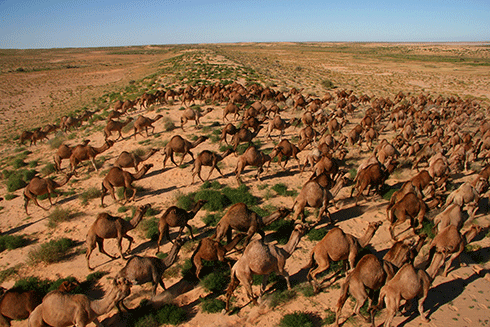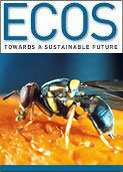
|
Published: 25 November 2013
Feral camel population must be kept down warns Ninti One
Australia needs to maintain strict vigilance to prevent an upsurge in feral camel densities, which would further devastate desert regions, native wildlife, the inland grazing industry and areas of importance to Aboriginal culture.

|
|
Feral camels being rounded up in the Simpson Desert area. Credit:
Ninti One
|
The recommendation follows a 4-year Australian Feral Camel Management Project (AFCMP), managed by Ninti One, which recently concluded.
The $15 million AFCMP, which began in 2009, has removed 160,000 feral camels from an area of around 660,000 square kilometres in remote Australia.
Among its achievements was forming a unique alliance of government agencies, pastoralists, Aboriginal communities, natural resource managers and the commercial camel industry to deal with the problem posed by a feral camel herd that had increased to unacceptable levels, Ninti One Managing Director Jan Ferguson says.
‘Feral camels may be the first widely established major pest animal in Australia that we have been able reduce to, and maintain at, acceptably low densities,’ she says.
‘There is now a real opportunity to maintain the low feral camel densities that had been achieved in the Simpson Desert and Pilbara regions.
‘However surveys indicate more work is required in the Surveyor Generals Corner region to reduce densities to the long-term goal of less than 0.1 animals per square kilometre – and this will require a concerted commercial use effort in conjunction with aerial and ground culling.
‘Failure to maintain the current pressure on the feral camel population will result in it rebounding to the unacceptable levels of impact which our monitoring program recorded at the outset.’
Ms Ferguson says the AFCMP should be seen as just the first step in a nationally coordinated feral camel management plan.
‘The extreme mobility of feral camels requires management across federal and state jurisdictions; not just across properties.’
Ms Ferguson said that among the outcomes from AFCMP
the commercial use industry was now better placed to help keep the camel population under control, Aboriginal landholders were better equipped to manage small localised feral camel problems through ground culling, and the efficiency of aerial culling has been enhanced.
‘We have also gained a great deal of scientific knowledge about feral camel population dynamics, behaviour and their impacts on the landscape, wildlife, grazing industry and Aboriginal culture. This will help guide future management planning,’ she adds.
The AFCMP also conducted extensive surveys (including aerial surveys) that now put the current population of feral camels at around 300,000 (down from the former population estimate of 750,000).
A short film about the feral camel project can be viewed here.
Source: Ninti One



